- Bernard Preston homepage
- Harvesting Rainwater
Rainwater harvesting model
A rainwater harvesting model for your home, garden or even small-farm is an imperative before you turn the first sod.
Without water nothing thrives; neither us, nor our gardens.
In an underground reservoir the water is much colder and we find it perfectly safe to drink; you may want to filter and boil it.
This page was last updated by Dr Bernard Preston on 9th April, 2024.
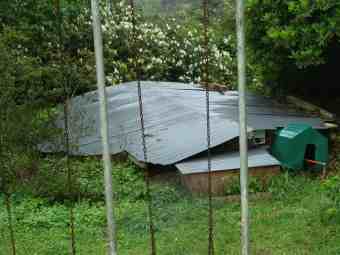
"We do not have to pay for wind and sun; the feedstock will come for free."
- Michael Power
Why might you want to do build such a thing? Well perhaps you are a greenie and want to save the planet. I do not have a problem with that; in fact it was a large part of my own motivation.
Perhaps you do not have reticulated-water available where you live; collect and store the rain or you will perish.
My own chief desire was to avoid the municipal supply in our village which is using very old and decaying asbestos-pipes; that means a deadly tumour called a mesothelioma.
Perhaps your utility is not managing things well and you are regularly getting diarrhoea. Many towns in South Africa now have a very high bacterial count in their reticulated water; not to mention plastic-microbeads and various chemicals like spent medicines.
If you live in the Third World as I do the water supply is probably unreliable and cut off periodically without notice for one reason or another; theft of the copper-wire supplying the pumps is a common source of irritation in our lawless land.
Large parts of Johannesburg were recently without water for a whole week. Edendale in my own neck of the woods has had none for months. Eco-friendly homes are coming into vogue to cope with problems like these.
Official SA statistics confirm that in 2017 less than half of South Africans had piped water where they live. If they have a roof over their heads with gutters, harvesting the rain with this model could change their existence.
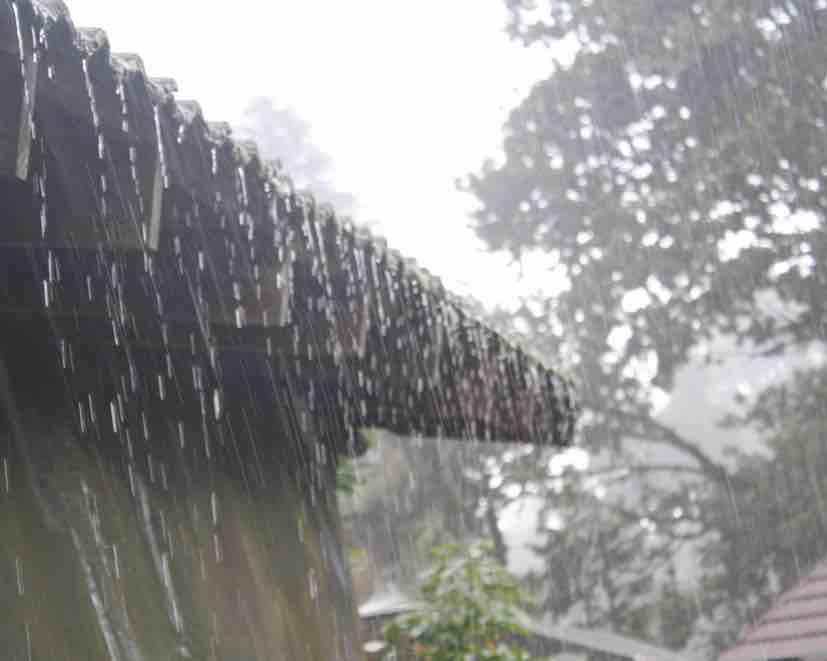
This family will have to collect water from the nearest stream.
"With the world's population expected to grow by one third to more than nine billion by the year 2050, it will according to the United Nations need to change.
- 70 percent more energy
- 55 percent more water."
Rainwater Harvesting Model
This is my rainwater harvesting model; it is a main feature of our backyard permaculture philosophy. Yours may be slightly different but it will need to include at least some of these features.
- Rainwater-collection
- Pipework
- Storage
- Pump and
- Filtration and perhaps sterilization.
Cost obviously is also a factor; that need not be excessive if you give due consideration to your rainwater harvesting model before making a start.
It took incidentally four strong men just a few days to dig the hole; the alternative is a far more expensive backhoe.
Water remains the bedrock of permaculture; without it no garden, or society as a whole for that matter, can thrive.
Two different models are considered at causes of water scarcity in the world; comparing the way it is done bigger and better in Texas with that in tiny Bermuda.
The size of your reservoir is obviously dependent on the weather patterns. Countries with a very short, wet season will need larger storage capacity which comes at a greater cost.
We decided on a roughly 25,000 litre tank; it is four metres in diameter, by two deep. That is enough to last about three-months, if conservatively used during the dry periods, assuming there is zero precipitation; usually we have some rainfall in winter.
Safety is a feature too; our reservoir is immediately adjacent to the children's swings. You do not want to have a tragedy. Heavy concrete weights or a locking system is vital to keep inquisitive kids firmly out.
We built into our model a sump for trapping solids from the roof; the pipework runs directly into a small recess, from which it overflows into the reservoir. It is filtered only by some discarded webbing from a lawnmower catcher-box. Cleaning the gutters is an important chore for every homeowner, but especially those who are harvesting the rain.
Make it large enough, and not too deep so you can easily climb in and clean out the debris and leaves; a square container like a five litre ice-cream box is perfect for scraping the bottom.
One can spend a lot of time and money on filtering the water; we gave consideration to various sand-traps but, at the end of the day, settled on something inexpensive and easy to clean.
At least every two months I siphon the water out of the trap and clean out the muck; it begins to stink if you leave it too long.
This trap needs to be about 700 mm deep and large enough so you can physically get in to clean it.
Ideally brick it to about 1000 x 850 mm. The point where the rainwater-pipes enter tends to leak; seal it properly.
Depending on the lie of the land, you may also want to consider an elevated fiberglass-tank from which you can gravity feed to your home and garden. It is much easier on the pump which will not need to cycle every time a tap is switched on or the toilet flushed.
A double-story house, like ours, means your rainwater tank would have to be elevated very high above the ground to give your shower sufficient pressure; I have decided against it for the present.
Rainwater collection
We have concrete-tiles on the roof and it is not ideal for rainwater harvesting model; a fine grit collects at the bottom of the trap. Clay-tiles, iron or a synthetic cladding would be better suited to cashing in on the benefits of rainwater.
PVC-gutters are useless and asbestos dangerous; aluminium is more costly but can be expected to last indefinitely. Ours are 35 years old and still in perfect condition.
Pipework for rainwater
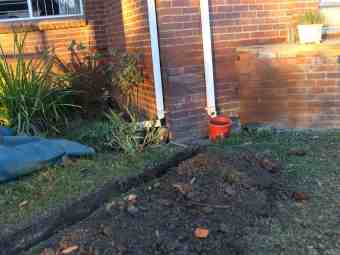
Dig trenches about a foot deep for your rainwater harvests, and then connect the downpipes to your reservoir. Standard 110mm UG PVC sewerage conduit is perfect.
At the final connection point, as we have a large roof, I wanted to have two-pipes in parallel to carry heavy rain.
Draw up a plan for your underground-conduits, and you may need a plumber to connect it up for you. Since it is not under pressure small leaks are not critical except in that final piping; there the water is nearly a metre deep at the bottom of the sump.
Having said that, we have found that 10mm of the light mizzle that characterises Hilton does not give the same result as an equal amount of heavy-rain; we are looking at sealing some of those small cracks I can see with fibreglass putty.
There are so many advantages of using a rainwater harvesting model; better for drinking, perfect for the vegetable garden, and good for the eco-environment.
Newsletter
Our newsletter is entitled "create a cyan zone" at your home, preserving both yourself and Mother Earth for future generations; and the family too, of course. We promise not to spam you with daily emails promoting various products. You may get an occasional nudge to buy one of my books.
Here are the back issues.
- Lifestyle and ideal body weight
- What are ultra-processed foods?
- Investing in long-term health
- Diseases from plastic exposure
- Intensive lifestyle management for obesity has limited value
- A world largely devoid of Parkinson's Disease
- The impact of friendly bacteria in the tum on the prevention of cancer
- There's a hole in the bucket
- Everyone is talking about weight loss drugs
- Pull the sweet tooth
- If you suffer from heartburn plant a susu
- Refined maize meal and stunting
- Should agriculture and industry get priority for water and electricity?
- Nature is calling
- Mill your own flour
- Bake your own sourdough bread
- Microplastics from our water
- Alternative types of water storage
- Wear your clothes out
- Comfort foods
- Create a bee-friendly environment
- Go to bed slightly hungry
- Keep bees
- Blue zone folk are religious
- Reduce plastic waste
- Family is important
- What can go in compost?
- Grow broad beans for longevity
- Harvest and store sunshine
- Blue zone exercise
- Harvest and store your rainwater
- Create a cyan zone at your home
Rainwater storage
My advice is to get a civil-engineer to draw up plans for you. At the depth of two or three metres the pressure is considerable and you do not want cracks developing.
Remember to put a sealant in the plaster, or you may have to fibreglass the inside of the tank; that is ideal, but expensive.
A roof is vital for your rainwater harvesting model, firstly to keep it dark stopping algae-growth, but also for safety. It also keeps leaves, etc out. It must have some form of trap, so that you can get into the reservoir; it needs to be cleaned annually.
Actually since putting in the coarse-filter where the water overflows from the initial sump into the main reservoir I now find there is very little detritus in the tank. I only empty and clean it out every second year now.
Nevertheless bacteria in rainwater in your reservoir should be a concern.
Losses
Worldwide losses in the reticulation are a huge problem, constituting what is known as non-revenue water.
In our city, Pietermaritzburg, it accounts for more than half the water drawn from the Umngeni-reservoirs.
On average around the world losses amount to around 35%.
In the mother city of South Africa, in desperate need in 2017, it is only 15-percent due to good government.
The joy of this rainwater harvesting model is that losses amount to zero; only when the underground reservoir needs to be cleaned. Wasting a kilolitre or two every second or third year is minute.
Water-scarcity in the world is set to increase and it is up to us to individually to become more resilient in the face of these challenges.
With only about 8 percent of downpours reaching rivers even if every single home built one of these rainfall harvesting models, it would still have almost no effect on large storage dams. It would also reduce storm-water damage.
Self-priming pumps
Only use self-priming pumps; much fewer headaches if it runs dry for any reason.
A submersible-pump is workable, but is not necessary.
The arguments go back and forth whether to use a bladder; we found it unnecessary with the modern-pump, where you can set the pressure at which it switches on. But that is utterly dependent on no leaks in the piping from your rainwater harvesting model.
Rainwater filter
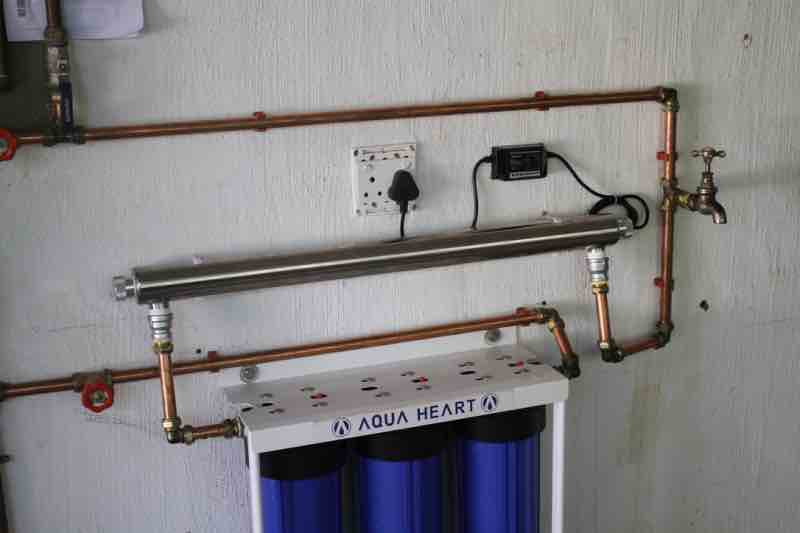
A variety of rainwater filters are available; remember they must carry a minimum of about 5-bars of pressure provided by your pump. The standard swimming pool sand-filter is not suitable.
I settled on this model; it must be firmly attached to the wall so that the bowl can be easily removed without stressing all the piping.
These filters will remove fine particulate matter but not bacteria. For that you will need ozone or UV-sterilization. You can see the stainless steel tube with a power cord?
Modern thinking is that exposure to a certain amount of bugs, bacteria and worms is actually good for us; without their stimulation, our immune-systems do not prepare us for the real world. Pathogens like E Coli we can do without obviously.
Diseases of the immune-system makes for an interesting read.
Note well that before unscrewing the filter-cover, you must first relieve the pressure. Turn off the pump, and open a tap to drain off some water.
Also before screwing the filter cover back onto its fitting, make sure you have filled it with water; otherwise that air will be pumped into your pipes causing gaseous locks and pipe-hammer. Any harvesting of the rain comes with its pitfalls for the unwary; first talk to those who are knowledgeable.
Just how safe is our drinking water? Researchers are now finding the residues of non-nutritive sweeteners that are causing really serious problems[1].
Rainwater tanks
If you are going to use an above ground rainwater tank, spend the extra and buy a fibreglass tank; they last indefinitely, even if standing in the full sun. PVC tanks do not.
Just how many suburban rainwater tanks would you need? It depends on the length of your dry-season, and whether you want to be entirely independent of the local utility.
But then if you are planning to pipe the rainwater into your home, you will need to sterilize it from an above-ground tank; the temperature is much higher and bacteria can multiply. Our harvesting model keeps it colder. We have no problems.
chlorination
Chlorination of bulk-water before it is supplied to the reticulation has been without a doubt one of the great breakthroughs in the prevention of the spread of diseases like typhoid and cholera from faecal-material.
But there is a downside; what effect does post-chlorination have on the microbiome in the human gut?
Indulgent shower
An indulgent-shower using the largest rose you can find is one of the joys of those who have invested in a rainwater harvesting model.
The bath vs shower debate has no merit in our home; we have our cake and can eat it.
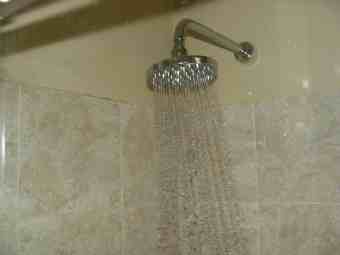
There are few greater pleasures than enjoying your indulgent, full-stream shower, using your own rainwater, heated by the sun, with a pump driven by your own solar generator.
Your rainwater harvesting model is a central feature of any backyard permaculture philosophy. It is needed for your veggies and fruit-trees, to supply the chooks and worms; and of course your home too.
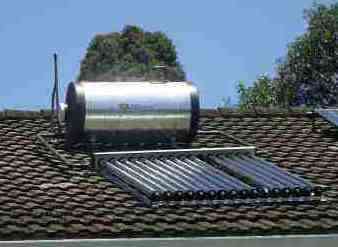
Harvesting rainwater and then heating it with sunshine is nature's way; collecting the energy from above and then turning it into electricity is rather more difficult, but of course plants have mastered it. Humans too can have an equally, totally-indulgent shower with no environmental downside.
It takes a determined person to make the switch from thinking someone else must provide what I should do myself, and become more self-reliant.
Solar generator
A solar generator collecting electricity from PV-panels, and then turning it into alternating current using an inverter is the next step, if you want to be a total greenie; this rainwater harvesting model may lead you on progressively on the green journey; your own personalised one.
For me it was vice-versa; I started with collecting sunshine, and only then moved on to harvesting rainwater.
Plan big and do not start with small panels as I did. I would not use anything less than 500 watt PVs today, if I was starting from scratch. A stud-diode has to be used if you use different voltages; try to use a uniform size and that means doing your planning right from the beginning.
For me our solar-generator is another central feature of our backyard permaculture, driving the rainwater harvesting model and providing power for our home; working with and not against nature is the name of the game.
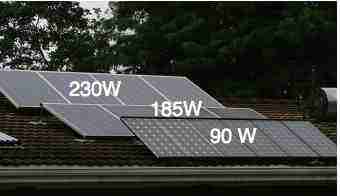
Illegal
Having spent a considerable sum on your rainwater harvesting model, you are now in a position to save money every month. In the minds of some strange people, you are robbing your municipality and they try to make it illegal.
Or insist you put a meter on it, and pay for the rainwater that falls on your roof.
We do not use the water; instead of passing straight from your gutters and downpipes, and thence back to the earth, we simply divert it first through our toilets, showers and gardens.
So storing and using rainwater is not such a big deal, is it? One does need to watch out for small leaks in the reticulation though, or the pump will cycle continually. Recently a licensed plumber installed a new geyser and over-tightened one nut; it cracked the pipe. It took us several irritating months to find the problem.
A shutoff-valve closes off the very old reticulation to the garden where there are several small underground leaks.
Electricity and water
The cost and provision of electricity and water are irretrievably linked. Generation of power using traditional turbines requires a great amount of rainfall.
Likewise pumping water consumes massive amounts of electricity.
Society appears unwilling to cut back on the use of either. That can only mean new infrastructure costing a great deal of capital, which of course is passed on to the consumer.
South Africa has just built with much fanfare a R200-million facility to extract potable water from the sea; what the minister did not say is that it uses R30,000 of electricity every day, and will provide only 90 litres for every family dependent on it; a mere drop in the ocean of need.
The solution for the individual is a rainwater harvesting model and generating solar power right in your own backyard. Neither are rocket science; there's plenty falling on the roofs of most homes. All you have to do is collect and store it. Purchase or build your own eco-friendly homes.
A panel of international and local experts in South Africa recommend that Eskom be allowed to buy power back from independent producers, presumably including home-owners, and educating the public about cutting back on water and electricity.
Are we willing? By sourcing one's own power and water from the skies one can use both generously and in a relatively unlimited fashion. Every homeowner should be looking into a rainwater harvesting model that suits their budget and needs.
Rainwater harvesting model
Rainwater harvesting model could be a reality in your home and garden. Ours is enormously successful. We now use virtually no mains water and zero electricity; it's possible we will need some from the utility in the future during an extended drought, so we have not gone off the reticulation system or grid.
But right now SA is in the midst of the worst drought in 40-years, and our reservoir is full; it's amazing just how much water can be harvested from just 5mm on your roof.
600mm of annual rainfall falling on a 200m2 roof will provide 1200 cubes of water; at least four-times our needs, for example. Read more from reservoir of knowledge in Daily Maverick[3].
Before setting off on this really quite major project, it is vital to talk to specialised folk, get advice and make sure your rainwater harvesting model is properly constituted before turning the first-sod.
The right specs for your reservoir otherwise it will crack and leak is the first step; a self-priming pump and what filter? How are you going to cope with having the option to draw either municipal or your own rainwater? How is it going to be efficiently collected from your downpipes? There's plenty of planning to be done.
Oh, and a non-return valve so that your water cannot be fed back to the mains supply.
Rainwater reticulation
Rainwater reticulation from your reservoir to the home and garden is the next step. Do not be tempted to use half-inch piping; once inside the house, yes, it is fine perhaps, but getting the water any distance requires a 25mm.
In fact, it made such a difference, I would put three-quarter in the house too, if I was to do it again.
Loss of pressure is considerable in a half-inch pipe if it is over any distance. It is 30m to our garden, plus the length of the hose; I ended up pulling up all that with a small diameter and replacing it.
There is a huge difference now in the pressure at the end of the hosepipe; in fact we can run two at once now.
For small amounts, a small fibreglass-watertank in the vegetable garden is useful, for filling a watering can. Place a tap nearby so you can fill it easily from the main reservoir.
Remember, once switched off, the hose running into the tank acts as a siphon; if there are any leaks the water will slowly drain from the tank.
A good valve at the pump for that running to the garden is essential. Any tiny leaks in your rainwater harvesting model will mean that it keeps recycling.
Rainwater harvests
Rainwater harvests not only the gift from heaven but also a lot of crud. A vital part of your model is how to clean out your tanks and reservoir.
Getting siphon started on sump makes your life a lot easier.
There are certainly a few tiny creatures swimming about in your reservoir; what do tadpoles eat you may be thinking?
Plant the rain
If you have never heard of Brad Lancaster, an American ecologist, then enjoy this inspiring TED video. He points out that even in drought stricken cities, more rain falls on the area than they can possibly consume. All we have to do is find ways to store it.
He does it by building sponges in his garden and down the street. They too use no municipal water. Inspired by a black Zimbabwean farmer, he calls it planting the rain.
Here is more about harvesting rainwater.
Population growth
Despite many doubts about long the world's population growth can continue as it is without calamity, a 33% growth in the population means a 7-times increase in food, according to the UN, remembering that one third that is produced is never actually eaten. Water scarcity in the world suggests that it simply cannot be done without a complete change of attitude.
Both the race to end waste and use of a rainwater harvesting model must be prime strategies.
So too new strategies to deal with waste-water.
Swimming pools
South Africans love their pools but they consume far more water. Evaporation is high in the summer-months.
The beauty of harvesting your own rainwater is that you have more than enough for the pool so you can keep fit without guilt.
Find out more about our solar swimming pool.
Stress
When water threatens to run out, people get stressed; seeing it leaking makes them mad. They get angry because they cannot irrigate the vegetables, their favourite plants and the pools; they may not wash their cars and have to take showers standing in buckets with a tiny-trickle from the rose.
A long generous shower is one of my most potent ways of de-stressing; breaking water releases negative ions into the air helping us relax.
Build you own rainwater harvesting model and you too can de-stress. You will have more than enough for every eventuality; the garden, the pool and generous showers. Make it larger than you think you will need; an extra metre in diameter adds very little to the overall cost.
Forest bathing is another way greenies can de-stress.
So, what is your water innovation?
Water scarcity
Are they cities in South Africa water scarce? Could this model for harvesting the rain be a solution? We think so though Cape Town and Port Elizabeth have low precipitation and long dry months.
Useful links
- Solar power energy home page.
- Cape Town water crisis: 7 myths that must be bust.
- Reservoir of knowledge. How we stopped using municipal water.
- Nonnutritive sweeteners can promote the dissemination of antibiotic resistance through conjugative gene transfer. Web: https://www.nature.com/articles/s41396-021-00909-x#Sec18
When browsing use right click and Open Link in New Tab, or you may get a bad gateway signal.
For more thoughts on "drinking water" type it into the Site search engine in the menu bar above.

Did you find this page interesting? How about forwarding it to a friendly book or food junkie? Better still, a social media tick would help.
- Bernard Preston homepage
- Harvesting Rainwater
Address:
56 Groenekloof Rd,
Hilton, KZN
South Africa
Website:
https://www.bernard-preston.com